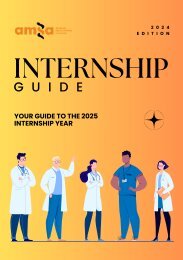AJGH Nexus - Volume 17 2023
AMSA Journal of Global Health (AJGH) 2023 Issue "Nexus"
AMSA Journal of Global Health (AJGH) 2023 Issue "Nexus"
Create successful ePaper yourself
Turn your PDF publications into a flip-book with our unique Google optimized e-Paper software.
department in OHCA patients in a low- or<br />
middle-income setting.[2] In fact, effective<br />
bystander CPR in OHCA can improve patient<br />
outcomes by 23-fold.[6] Bystander CPR is only<br />
one of many pre-hospital factors<br />
contributing to those outcomes.<br />
Access to emergency services in low- and<br />
middle-income countries is severely<br />
impacted by financial and resource strain. A<br />
systematic review performed in 2018 found<br />
that prehospital factors such as<br />
culture/community,<br />
infrastructure,<br />
communication/coordination, transport,<br />
equipment, and personnel are major barriers<br />
to timely and effective care.[7] Community<br />
understanding and recognition of medical<br />
emergencies can be limited due to poor<br />
health literacy, highlighting a barrier to<br />
identifying the need for CPR. Poor roads in<br />
rural settings and congested thoroughfares<br />
in urban settings make ambulance<br />
transportation very difficult. Increased<br />
distances from appropriate health facilities<br />
increase mortality by 2% with every 10%<br />
increase in distance. Emergency transport<br />
services, such as ambulances, are available to<br />
less than 1% of the population in many lowand<br />
middle-income countries.[7] A lack of<br />
trained personnel and equipment in<br />
emergency responders from services is<br />
additionally marked. I recall ambulances<br />
arriving at the emergency department in<br />
Cambodia with patients who had suffered<br />
road accident trauma using tourniquets<br />
made from scraps of clothing. In contrast,<br />
Australian paramedics are afforded the<br />
resources to be trained as first-responders<br />
and thus can provide exceptional assessment<br />
and management of medical emergencies<br />
before they arrive at a hospital.<br />
It is clear then that CPR is only one of<br />
multiple factors that affect patient outcomes<br />
significantly following OHCA. However,<br />
evidence points to the significant positive<br />
impact that the delivery of high standard CPR<br />
by bystanders can have in improving patient<br />
outcomes. Community knowledge and<br />
training in CPR and BLS is significantly<br />
limited in LMICs compared to Australia.<br />
There appears an opportunity here for<br />
bystander intervention to fulfil the dogma of<br />
timely and effective CPR in OHCA in low- and<br />
middle-income settings.[6]<br />
Increasing community awareness and<br />
proficiency in CPR may be considered a costeffective<br />
solution, since CPR requires only 4<br />
hours of instruction according to the<br />
American Heart Association.[8] However,<br />
delivering this training in LMICs raises<br />
several dilemmas. The fragility of the “chainof-survival”<br />
in LMICs is an important<br />
consideration. It describes the integration of<br />
community-wide CPR training, public access<br />
to AEDs, prehospital and healthcare facility<br />
emergency care with ongoing intensive and<br />
rehabilitative care .[8] A weak link in this<br />
chain can negatively impact patient<br />
outcomes; and in LMICs there can often be<br />
multiple weak links. Compounding this is a<br />
compromise in patient autonomy which<br />
stems from socio-cultural differences in<br />
understanding of CPR and end-of-life care<br />
with unsuccessful resuscitation. This is<br />
because varying levels of health literacy can<br />
result in misunderstanding and confusion for<br />
family members regarding end-of-life care,<br />
potentially prolonging patient suffering after<br />
inadequate resuscitation and delaying “last<br />
rites” in religious traditions.[8] It also calls<br />
into question the nonmaleficence principle,<br />
or ‘do no harm’. CPR training should, at a<br />
minimum, provide certification and refresher<br />
training to ensure up-to-date and highest<br />
possible standard of CPR provision.[8] This is<br />
challenging to achieve in a resource-limited<br />
setting, which can precipitate iatrogenic<br />
harm. Similarly, upholding beneficence when<br />
providing CPR in a resource-limited setting is<br />
difficult if outcomes include disability or<br />
insurance costs that cannot be managed by<br />
the patient or family’s financial backing.[8]

















